You probably need to get your intended semantics straightened out a little bit more.
From what I gather, you want isFriendWith at least to be symmetric, i.e. when isFriendWith(bob, alice) then also isFriendWith(alice, bob).
Also, if you want to have friendsAll to have any meaning, isFriendWith cannot be transitive. This would also capture the natural meaning, as a friend of my friend is not necessarily my friend.
To elaborate: If isFriendWith where symmetric and transitive every friend of bob would automatically also be a friend of all of bob's friends (because isFriendWith(bob, alice) implies isFriendWith(alice, bob). From there on, with any isFriendWith(bob, carol) transitivity implies that isFriendWith(alice, carol). So if isFriendWith is symmetric and transitive, you get the clique automatically.
But as stated, this is probably not, what you want.
As for formulating this in SWRL, let's give it a try, shall we?
friendsAll is most likely reflexive, i.e. let's just assume everybody is his/her own friend. Now, we need an recursive rule that extends this set while still fulfilling the condition: "In this set, everybody is everybody's friend".
To include bob's friends, you would need to be able to quantify over isFriendWith and check if that any candidate friend of bob is also a friend of all other friends of bob. Since you cannot nest quantifiers in SWRL, I'm more or less sure, you cannot express that algorithm in the rule language alone. However, I maybe wrong here and there is a neat little trick hidden inside the semantics. It is not one that I know of, however and the need for quantifier nesting in the direct formulation leaves me believing that it is not possible.
It basically boils down to a well-known graph-theoretic problem: given a starting point bob friendsAll is the largest subset of bob's friends such that every everbody in the group is friends with everyone else, i.e. bob's Maximal Clique.
